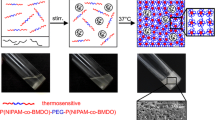Abstract
Purpose. To characterize novel pharmaceutical organogels based on the self-assembly of L-alanine derivatives in hydrophobic vehicles.
Methods. The gelation properties of N-lauroyl-L-alanine (LA) and N-lauroyl-L-alanine methyl ester (LAM) were investigated in the presence of various solvents. Gel-sol and sol-gel transitions were evaluated by the inverse flow method, and gelation kinetics were determined by turbidimetry. The in vitro release kinetics of labeled dextran physically dispersed in the oil-based organogel was assessed in phosphate-buffered saline. In situ formation of the implants was evaluated in rats by subcutaneously injecting a solution containing LAM, an oil, and a water-diffusible inhibitor of self-assembly (ethanol).
Results. The LAM-containing formulations showed a hysteretic gelling behavior with transition temperatures between 10 and 55°C. Gelation kinetics exhibited a lag time of 10 and 30 min at 25 and 37°C, respectively. In vitro, fluorescein isothiocyanate-dextran was released from the gel in a sustained manner with less than 6% released after 20 days. The addition of ethanol to the LAM/oil mixture inhibited gelation and allowed subcutaneous injection of the solution at room temperature. After injection, ethanol diffusion led to the formation of a solid implant.
Conclusions. Low-molecular weight self-assembling organogelators may allow the preparation of novel in situ-forming hydrophobic implants.
Similar content being viewed by others
References
T. P. Johnston, M. A. Punjabi, and C. J. Froelich. Sustained delivery of Interleukin-2 from a poloxamer 407 gel matrix following intraperitoneal injection in mice. Pharm. Res. 9:425-434 (1992).
E. Ruel-Gariépy, A. Chenite, C. Chaput, S. Guirguis, and J. C. Leroux. Characterization of thermosensitive chitosan gels for the sustained delivery of drugs. Int. J. Pharm. 203:89-98 (2000).
R. E. Eliaz. and J. Kost. Characterization of a polymeric PLGA-injectable implant delivery system for the controlled release of proteins. J. Biomed. Mater. Res. 50:388-396 (2000).
J. Cappello, J. W. Crissman, M. Crissman, F. A. Ferrari, G. Textor, O. Wallis, J. R. Whitledge, X. Zhou, D. Burman, L. Aukerman, and E. R. Stedronsky. In-situ self-assembling protein polymer gel systems for administration, delivery and release of drugs. J. Control. Rel. 53:105-117 (1998).
B. O. Haglund, R. Joshi, and K. J. Himmelstein. An in situ gelling system for parenteral delivery. J. Controlled Release 41:229-235 (1996).
B. Jeong, S. W. Kim, and Y. H. Bae. Thermosensitive sol-gel reversible hydrogels. Adv. Drug Deliv. Rev. 54:37-51 (2002).
S. Engström and L. Engström. Phase behavior of the lidocaine-monoolein-water system. Int. J. Pharm. 79:113-122 (1992).
A. Hatefi and B. Amsden. Biodegradable injectable in situ forming drug delivery systems. J. Control. Rel. 80:9-28 (2002).
P. Terech and R. G. Weiss. Low molecular mass gelators of organic liquids and the properties of their gels. Chem. Rev. 97:3133-3159 (1997).
S. Murdan, V. D. Bergh, G. Gregoriadis, and A. T. Florence. Water-in-sorbitan monostearate organogels (water-in-oil gels). J. Pharm. Sci. 88:615-619 (1999).
S. Bhattacharya and Y. Krishnan-Ghosh. First report of phase selective gelation of oil from oil/water mixtures. Possible implications toward containing oil spills. Chem. Commun. 2:185-186 (2001).
M. George and R. G. Weiss. Chemically reversible organogels via “latent” gelators. Aliphatic amines with carbon dioxide and their ammonium carbamates. Langmuir 18:7124-7135 (2002).
T. Tomari and M. Doi. Hysteresis and incubation in the dynamics of volume transition of spherical gels. Macromolecules 28:8334-8343 (1995).
H. Reithmeier, J. Herrmann, and A. Göpferich. Lipid microparticles as a parenteral controlled release device for peptides. J. Control. Rel. 73:339-350 (2001).
T. Eldem, P. Speiser, and H. Altorfer. Polymorphic behavior of sprayed lipid micropellets and its evaluation by differential scanning calorimetry and scanning electron microscopy. Pharm. Res. 8:178-184 (1991).
Author information
Authors and Affiliations
Corresponding author
Rights and permissions
About this article
Cite this article
Couffin-Hoarau, AC., Motulsky, A., Delmas, P. et al. In situ-Forming Pharmaceutical Organogels Based on the Self-Assembly of L-Alanine Derivatives. Pharm Res 21, 454–457 (2004). https://doi.org/10.1023/B:PHAM.0000019299.01265.05
Issue Date:
DOI: https://doi.org/10.1023/B:PHAM.0000019299.01265.05




